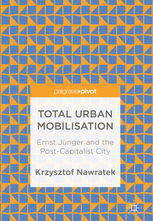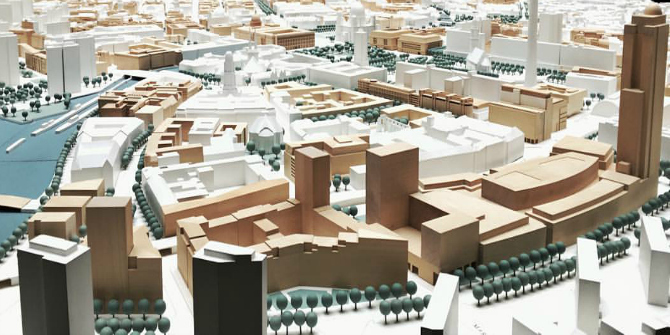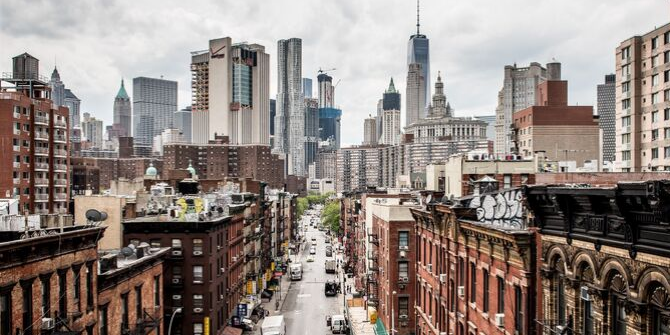In Total Urban Mobilisation: Ernst Jünger and the Post-Capitalist City, Krzysztof Nawratek offers a collection of essays exploring the post-capitalist city, positing ‘the accumulation of agency’ as a driver of urban development to act against the logic of capitalist accumulation, drawing on and reclaiming Ernst Jünger’s notion of ‘total mobilisation’. This short yet polyphonic book will be of interest to practitioners and theorists of urban change, writes Natalia Romik.
Total Urban Mobilisation: Ernst Jünger and the Post-Capitalist City. Krzysztof Nawratek. Palgrave. 2018.
 Find this book (affiliate link):
Find this book (affiliate link): ![]()
In Total Urban Mobilisation, Krzysztof Nawratek draws a dense, theoretical map of post-capitalism, which can be traversed by taking crisscrossing routes and forking pathways. This short yet surprisingly polyphonic book is composed of theoretically rich essays that introduce readers to a network of precariously overlapping social, political and urban systems. It is a multilayered story-within-a story, where the main protagonist is played by Ernst Jünger, who guides us through a thicket of theoretical references to submerge us in what Nawratek calls a ‘post-capitalist forest’. Jünger himself is an ambiguous figure, a renowned writer, a conservative engaging in the philosophies of psychedelic experience, a German soldier of World Wars I and II who partook in the conservative revolutions of the 1920s and yet was never aligned with the Nazi regime. Nawratek’s ambition is to rehabilitate this thinker, in his opinion undeservedly forgotten, just as Chantal Mouffe sought to rethink the legacy of Carl Schmitt.
The entire methodology of Nawratek leans strongly on Jünger’s concept of the ‘stereoscopic view’, sometimes compared to Walter Benjamin’s concept of the dialectic image. Nawratek tries to establish a radically inclusive perspective that does not thrive on a dialectic clash of oppositions in order to arrive at a new synthesis. Instead, the stereoscopic view triangulates seemingly contradictory processes in order to reach out to another level that promises to provide a more informed insight into the social gestalt: that is, the entirety of human relations. For the idea of gestalt, Nawratek references non-Western philosophical concepts such as the Chinese ‘All-Under-Heaven’ (Tianxia, a ‘world under a commonly agreed institution, a plan to make the world a place of world-ness’, 85) and deconstructs the tripartite definition of space offered by Henri Lefebvre (space – space of representations – spatial practice). To emphasise the messianic tone of gestalt (or world-ness), Nawratek refers to the philosophy of Jacob Taubes, who explains the history of the Jews as that of people rooted in time rather than space, whose future is driven by a collectively shared promise, a goal that transcends a mere here and now.
This radically inclusive method, with philosophical roots in conservative and non-Western traditions, impacts how Nawratek perceives both the capitalist and post-capitalist city. In contrast to the socialist planners of old or the new theoreticians of the commons such as Michael Hardt and Antonio Negri, Nawratek’s critique of capitalism does not emphasise property relations (the ownership of space and capital), but rather the degeneration of human agency that results from the capitalist logic of finance (or possibly, in addition, Soviet master planning). It has to be underlined that Nawratek is clearly and unapologetically critical of neoliberal capitalism, which he views as a ‘deeply unethical socio-economic regime’. He identifies the ‘black holes’ of the current spatiotemporal order of late capitalism, a discontinuum of precarious and deskilled human lives, that are stripped of agency by ‘bullshit jobs’ and zero hours contracts, in tune with the recent analysis of David Graeber. Nawratek emphasises that capitalism is not only an economic system but a mechanism of ‘constant reproduction of the existing structure of power’: a remark that resonates soundly in the age of financial oligarchies and an exorbitant accumulation of wealth.
Nawratek’s project aims at developing non-Marxist concepts of the post-capitalist city that would safeguard the equality, diversity and distributed agency of its denizens. Leaning on Kojin Karatani’s analysis of different modes of exchange, Nawratek imagines the post-capitalist city as an embodiment of the logic of mode D of exchange (mode A being a primary model of gift exchange; B of plunder and expropriation; and C of capitalist extraction): namely, a ‘better gift giving’ that does not entail a direct but rather more universal forms of reciprocity. According to Nawratek, such a post-capitalist city should aim at enhancing human agency, as for him post-capitalism engenders the accumulation of this rather than wealth.

However, this agency is distributed not amongst a conglomerate of atomised individuals (as in a neoliberal society where dog-eats-dog), but rather flows through some sort of assembly-of-social-assemblages. In imagining this type of social order that surpasses individual agency with a collective purpose, synthetising religious and socialist imaginaries, Nawratek continues the lines developed in his previous books such as City as a Political Idea: Citizenship, Sovereignty and Politics (2011). In contrast to liberal thinkers, such as Hannah Arendt, who often idealise the Greek polis, Nawratek is a vehement critic of what he describes as a xenophobic, unequal, militarised and inward-looking model. He rather looks for the roots of Western urbanity in the Roman urb, an interconnected city that was embedded in the political order of the Roman empire and flourished due to this embedment in the flows of goods and bodies. For Nawratek, this pre-modern, and thus inherently non-totalitarian, form of empire that hosted a radical heterogeneity of diverse cultures and economies is a dialectic image of the post-capitalist city.
Obviously, Nawaratek’s project regarding the post-capitalist city must not only involve an image of the new urban order, but also a theory of social change. Here, Nawaratek leans on Jünger’s concept of ‘total mobilisation’ that – in Nawratek’s own words – ‘goes beyond the logic of individual gain and focuses on a non-homogeneous unity, […that] gives a framework and a goal, but also freedom to define how this goal could be achieved’ (7). It is an interesting take on understanding collective agency, not so different from such Marxist concepts as class consciousness or more recent theories of the multitude or commonwealth. However, Nawratek’s declared aim is to develop a conservative form of post-capitalism that otherwise seems to be a domain of the progressive left.
Like Rosa Luxemburg, the author sees capitalism as a process of accumulation that – in order to continue – has to absorb its own, non-capitalist peripheries, drawing energy from them. When reading this book, we have (rightly) the impression that the relationship between capitalism and post-capitalism is always asymmetrical, as suggested by Karatani. Fortunately, Nawratek maps not only structures of reproduction, but also directs readers to the ‘urban islands of hope’: urban spaces, such as offices or workshops, currently dominated by the logic of finance but which can be rearticulated in their non-capitalist heterogeneity.
In this respect, Nawratek’s understanding of social change contributes to the project of imagining post-capitalism beyond the Marxist perspective. In contrast to more dialectically oriented or utopian thinkers, Nawratek does not envision revolutionary change; as a conservatively leaning thinker, he is rather dubious of such ideas. He traces processes of the accumulation of agency that engender in the cracks of the capitalist city and are able to eventually overshadow the logic of capital. However, according to Nawratek, this agency won’t result from the spontaneous movements of the multitudes, anarchist occupations or bottom-up mobilisations. Instead, total urban mobilisations are embedded in the shared purpose of ‘top-down revolutions’, such as general strikes in Fordist industries that mobilised armies of the industrial proletariat in a project larger than any individual worker that partook in them. It is definitely a discussable concept, and Nawratek does not shun from the controversy or gloss over it. Instead, after Jason Moore, he points to the inevitable climate catastrophe as both an existential threat and a chance to accumulate human agency beyond the constraints of the capitalist city.
Summarising, Nawratek’s route through the thicket of the ‘post-capitalist forest’ cannot be easily categorised. He does not follow a lazy path: his routes are curved as he moves through multilayered sets of references that on the first glance might seem to be contradictory, in one breath quoting conservatives and revolutionary Marxists. But this book is not an undisciplined mix-and-match of intellectual curiosities. Because his narrative of the post-capitalist city is consequently driven by the methodical application of the concept of the parallax view, readers arrive at a convincing vision of total urban mobilisation. It might come that such a dialectic image is precisely what is needed to brave the contradictions inherent to neoliberal urbanisation, only accelerated by the looming climate catastrophe. In any case, immersing oneself in the ‘post-capitalist forest’, alongside Nawratek and Jünger, is a venture worth risking for all practitioners and theorists of urban change.
Note: This review gives the views of the author, and not the position of the LSE Review of Books blog, or of the London School of Economics. The LSE RB blog may receive a small commission if you choose to make a purchase through the above Amazon affiliate link. This is entirely independent of the coverage of the book on LSE Review of Books.
Image Credit: Photo by Pedro Lastra on Unsplash.







